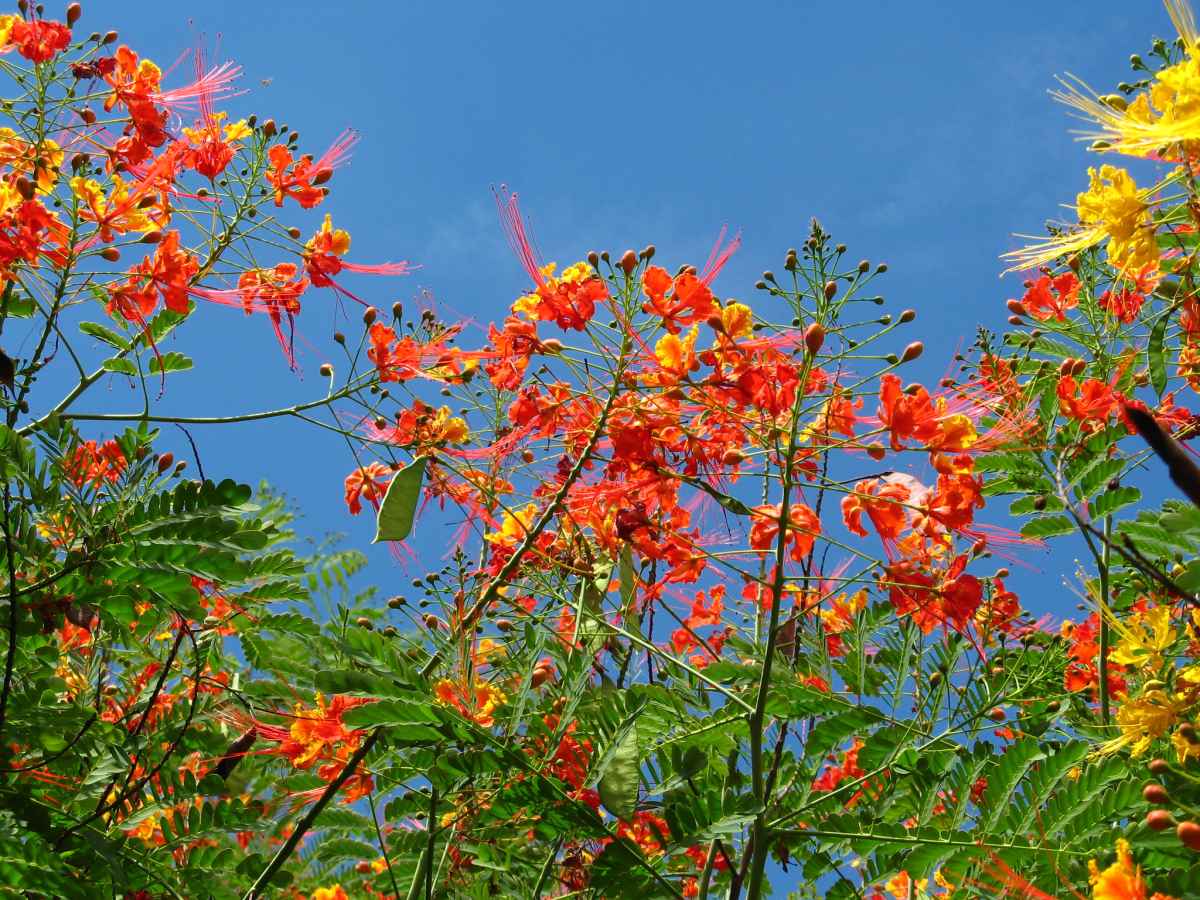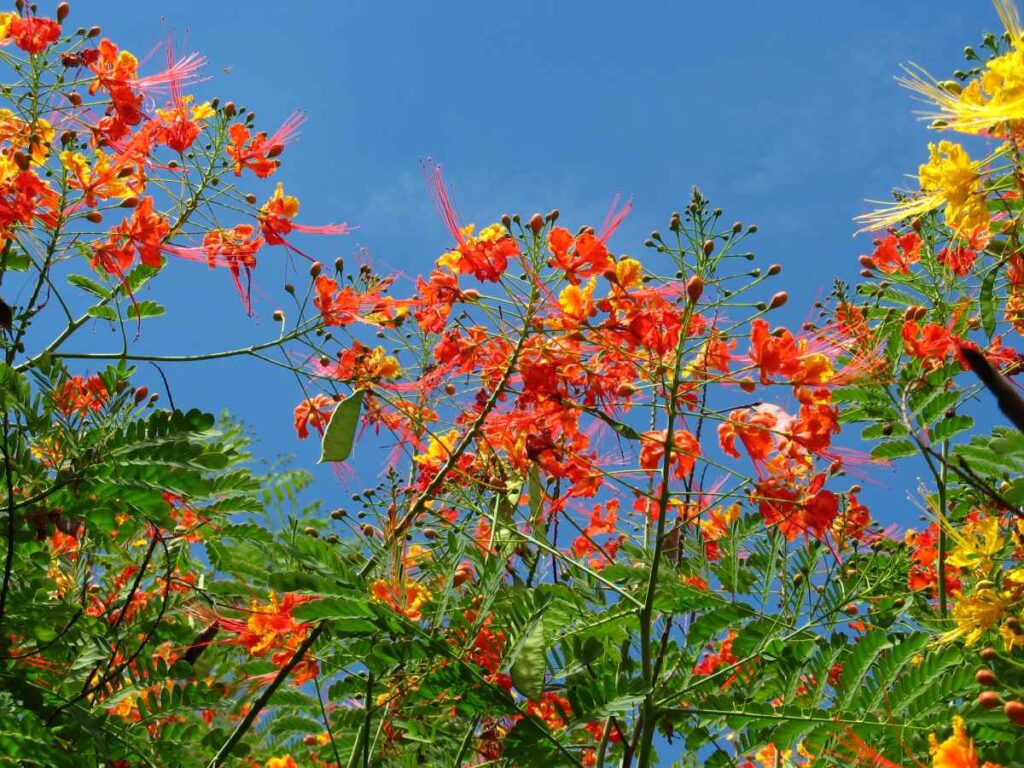Mexican Bird Of Paradise Care – How To Grow And Care For Mexican Bird Of Paradise Plant
There are shrubs and then there’s the Mexican Bird of Paradise shrub. While it resembles a miniature tree growing as high as 15 feet and with a similar width, this is a delightful shrub with yellow flowers that bloom in the spring and summer. You can prune it to make it a shrub or let it grow into a small tree.
What makes the Mexican Bird of Paradise such a right fit in your garden is that it is easy to grow, doesn’t require much care, and has a moderate to slow growth rate. A native of Northern Mexico, Caesalpinia Mexicana cuts a fine figure with its feathery green leaves and yellow flowers that grow on spikes. Once the flowers fade, pods packed of seeds appear on the spikes and explode spreading their seeds everywhere.
Bird of Paradise Varieties
The bird of paradise or Caesalpinias, is a family of shrubs that vary in size and if left on their own, they’d become small trees. They all have one thing in common, they can survive in harsh conditions and are accustomed to little water and dry and hot weather. So which variety fits in your garden or lawn? Here are the most popular ones.
- Desert Bird of Paradise (Caesalpinia gilliesii): the leaves on this shrub are usually small compared to the large yellow blossoms and the red stamens that shoot out of them like arcs of fireworks. The maximum height of this shrub is about 10 feet although in gardens it averages 6 feet both in height and width. The flowers blossom in the spring and fall then fade to be replaced by the wooden pods. This is a deciduous shrub that looks bare in the winter.
- Red Bird of Paradise (Caesalpinia pulcherrima): while not as tolerant of the cold weather as their desert cousins, this species goes above and beyond with their vibrant flowers. With shades of orange and red, this is one shrub to stand out in your garden and get all the attention. The shape of the shrub resembles a vase and it needs full sun and high temperature to blossom. It keeps its leaves during the winter months and they turn a lovely shade of red.
- Mexican Bird of Paradise (Caesalpinia mexicana): our Mexican branch of the family is not as flashy as the other species. At least as far as its timid and mono-colored flowers are concerned. But the ferny leaves really stand out with their deep shades of green. You can prune it to control its foliage and keep at it 8 feet in width and height. It fits nicely in many landscapes from the desert to tropical and natural. It only needs little watering during the flowering season and can survive on underground water for the rest of the year.
How to Grow Mexican Bird of Paradise from Seed
You can propagate the Caesalpinia mexicana in one of many ways. Layering and cutting are common ways to grow the shrub. But as it produces an abundance of seeds every year, many horticulturalists prefer seeds as a means of propagation that gives them more control over the species and its features. The only drawback is the seeds are hard and require plenty of processing and treatment before you can plant them.
- Before you can plant the seeds, you need to gather them first. In the fall, the pods on the tree turn brown and swell up. Gather them before they explode and spread their content all over the garden.
- Spread the seeds on a towel in the sun and leave them to dry. Then store them in a sealed jar and keep them in the fridge.
- About six weeks before the last frost, take the seeds out of the fridge. Make a small cut in the shell and soak them in a bowl of warm water for 24 hours. Discard any seeds that don’t sink to the bottom immediately.
- Fill a pot with equal portions of potting soil and sand or perlite. Make sure the pot has plenty of drainage holes at the bottom.
- Plant the soaked seeds keeping a distance of 2 inches between each seed. They should be about half an inch deep into the soil and water them lightly.
- Spread a sheet of plastic over the pot to protect it against the cold temperatures. Make sure the room temperature is around 77 degrees F to help with germination.
- Keep the soil damp throughout until the seeds sprout between one and four weeks later.
- Remove the plastic cover and put the pot in a window sill that gets full sun or under a lamp.
- When you see 4 leaves at the top of the seedlings, it’s time to transplant them each in its own pot with the same soil mixture.
- After the last frost, move the pots outside to adjust the plant to outdoor conditions before you transplant them to their permanent location in the garden.
Mexican Bird of Paradise Care
With the Mexican Bird of Paradise growing in your garden, your work is not over. In fact, it’s just beginning. While the mature shrub is famously self-dependent and doesn’t make a fuss except with the spreading branches and leaves, you still have a lot of work to do before you can get to that stage.
Soil
The permanent soil in your garden is different from the one you use to germinate the seeds of the Mexican Bird of Paradise. The shrub can handle all kinds of soil from clay to loam types. As long as it’s well-drained, you have nothing to worry about. Before the shrub reaches maturity, you need to make sure the soil is moist most of the time especially during the hot summer months.
Light
As a shrub that grows in the Northern Mexican regions, the Mexican Bird of Paradise needs a lot of sunlight to grow and produce flowers. In your garden, make sure you plant it in a spot facing the south or west to get the longest hours in the sun. Partial shade might not affect the growth of the shrub but it will put a dent in the blooms.
Water
The soil needs to be moist while the plant is still in its nascent stages. This includes when the seeds are germinating, the seedlings growing, and the first few months after transplanting the plant to its final destination in your lawn or garden. But once the roots establish and the plant shows signs of maturity, it can do away with irrigation altogether. You still need to water it once every two weeks during the growing season in the spring and summer.
Temperature
The Mexican Bird of Paradise falls within the USDA hardiness zone of 9 which means it can tolerate cold weather although it prefers high temperatures between 60 to 78 degrees F. When the temperature falls below 32 degrees F, the plant goes into dormancy. It’s not dead though. Because by the next spring it will come back to life with leaves sprouting everywhere.
Fertilizer
You don’t have to use organic compost or chemical fertilizers with the Mexican Bird of Paradise. Much like cactus, it’s used to the rough and tumble of the Mexican desert and can survive on the bare minimum of nutrition and water. Still, if you want to encourage it to produce an abundance of vivid yellow blooms, you could use a 20-20-20 fertilizer in small doses in the late spring and early summer.
Pruning
By far the most work you will be doing with the Mexican Bird of Paradise will be related to pruning. Even though it’s a slow growing shrub, you still need to keep your pruning scissors handy. If left to its own devices, the shrub will grow into a small tree and spread far and wide. Once the fall season winds down, get cutting the branches to protect the plant against the onslaught of the frost.
Toxicity
One thing to keep in mind when collecting the seeds is that they are very toxic. You should keep them away from children, animals, and birds in your household. When you store the seeds in the fridge, clearly label the jar. Symptoms of poisoning include mouth irritation, stomach ache, and nausea and vomiting in severe cases. Birds are more vulnerable and a few seeds can be fatal. In the case of large animals and children, the symptoms are mild and the treatment is limited to drinking large amounts of water.
Pests and Diseases
In its natural habitat, the Mexican Bird of Paradise can handle anything Mother Nature throws at it. However, when it grows in a lush garden, it has to grapple with invading bugs that don’t usually survive in the desert. Among those, aphids and powdery mildew are the ones who target the shrub in its early phases before it matures. Keep in mind that most infestations happen when the plant lacks water or enough light. The soil should be moist to help the shrub grow and make sure it gets at least 5 hours of full sun every day.


I need bushes for a hedge in 85123 Pinal county, AZ. I have Arizona Prairie Dogs eating every bush I grow, plus cute but ravenous rabbits, including Arizona Yellow and Blue Bells. Two questions please: Will the Prairie Dogs and rabbits eat Mexican Bird of Paradises up; the leave and roots and stems killing them? And will they poison my dogs?
they ate mine…I put a 1′ cage around them and it let them get larger they pop over the wire now but no one has bothered to try and eat them…I’m in Buckeye
According to gardenguides.com,Bird-of-Paradise Toxicity – Garden Guides, If you eat the seeds or the angled seed capsule of the bird-of-paradise plant, internal poisoning can occur, according to the government of Alberta, Canada. Vomiting is one of the symptoms these plant parts can cause. The seeds also cause poisoning in dogs and other animals that eat them.
So it may not be a good fit around dogs. I can’t speak for whether or not prarie dogs/rabbits will eat them, I keep mine in a big pot (because I have a similar problem with gophers).
I have several of these bushes, and love them. They attract lots of butterflies and hummingbirds. I also have 2 small dogs that enjoy the shade below them and don’t try to eat the seeds. We had gophers or moles eat almost all of the roots of our agaves. They did not eat these.
What is a good time of year to dig one of these out and re-plant (new location on same property) . I have several ‘volunteers’ around my established bushes and would like to move them to provide space. the volunteers all have several branches each, and are from 1 foot to 2 feet tall.
what are the brown pods? do you cut them off leave them?